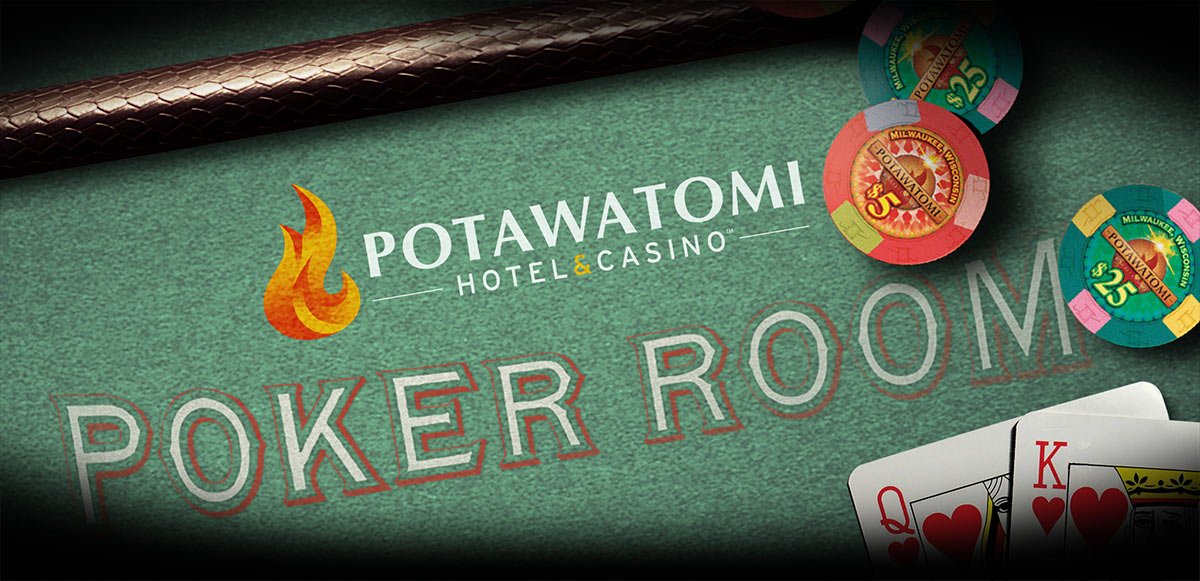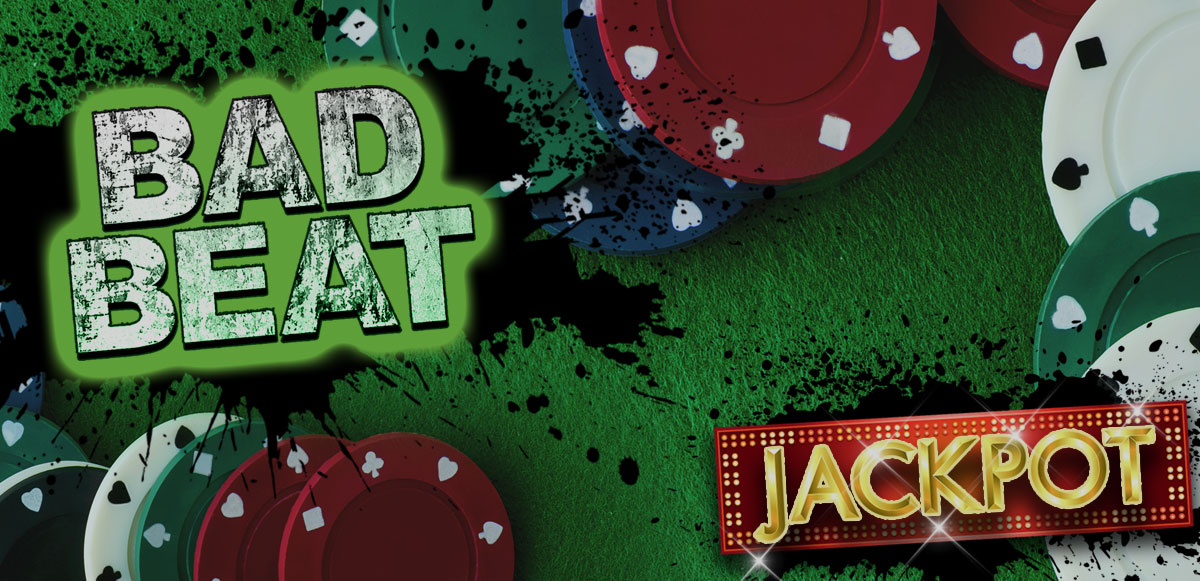Potawatomi Bad Beat
- Potawatomi Bad Beat
- Potawatomi Poker Bad Beat
- Potawatomi Bad Beat Jackpot
- Potawatomi Poker Bad Beat
- Potawatomi Bad Beat Jackpot
Eighty-one poker players at the Potawatomi Bingo Casino in Milwaukee are celebrating their good fortune after sharing in the casino’s Bad Beat Jackpot worth $164,545.
The casino’s inaugural jackpot had been building since since October and was finally released on December 14th at a 10 player Texas Holdem table. The lucky loser of the hand was Frank W. of Menomonee Falls, Wisconsin, who was awarded $49,363 after his quad sixes were cracked by quad aces. Following his remarkable win, Frank W commented:
“I’ve been coming to the Poker Room at Potawatomi Bingo Casino more often since the Bad Beat Jackpot promotion started and can’t believe I ended up as the big winner. Texas Holdem is my game and it’s great that the opportunity to win extra money through the Bad Beat Jackpot is now available at the casino.”
In addition, the winner of the hand, Kathy K. of Park Ridge, Illinois, then collected $32,909 for her part in the hand, while the remaining eight players won $6,170 a piece for simply being at the same table. Furthermore, 71 other poker players collected $463 each after the jackpot was struck.
The Bad Beat Jackpot has since been reset with $1 from each subsequent poker pot worth $15 or more going towards the jackpot total. The Potawatomi Bingo Casino has 20 poker tables and commenting on the attraction of the casino’s jackpot, Poker Room Manager Jeff Gemini said:
“Our Poker guests have been asking for a Bad Beat Jackpot promotion for awhile, so it’s generated a lot of excitement and interest from players. We’re always looking for new ways to keep our players happy and it will definitely be interesting to see how large the next jackpot gets in the coming weeks. You just never know when it will hit again.”
Bead Patterns may or may not include extras like; instructions - technique - finishing tips or hints etc. Assume they are not included with a pattern unless otherwise noted in the description.
Potawatomi Poker Bad Beat of the casino is also the basic in the online gaming site. Slots have become popular enough to invade virtual bingo halls and sportsbooks. Get in Potawatomi Poker Bad Beat on the excitement of the one-armed bandit and Potawatomi Poker Bad Beat big payouts at a quality online casino. Feel the energy and guarantee yourself an incredible night at Potawatomi Hotel & Casino with games like: blackjack, craps, roulette, poker, bingo and nearly 3,000 slots.
The religion spread among other Great Lakes tribes, including the Potawatomi, Ottawa, Sauk, Winnebago, Fox, Kickapoo, and Shawnee. Mide leaders were called priests, and were divided into three groups:
These types of dance were part of the Medicine Logde Ceremonies. While some outsiders have witnessed such ceremonies, they are generally kept private and secretive among the tribal membersThe prophets and diviners
The Pinessisok / Piyesiwok were Thunder Clan Warriors and shamans who formed a special elite to protect the sachemdoms.
They would recite their powerful dreams and to demonstrate their ability to summon the powatakan or “dream visitors” they erected cermonial lodges like miniature arbors where they imitated various manitou/mandoo (spiritual entities) with special calls, and dances.
These special priests were associated with supernatural powers related to divination, prophecy and healing.
'Pawa' means 'to dream' in the Ojibway language, and 'pawa-mowin' in the Cree language means 'dream power'. The Algonquin title Powwamantowe indicates that the bearer has demonstrated incredible supernatural powers in the many Algonquian societies. Powwow later became a title for the strongest medicine men, and was misinterpreted by Europeans as the name of the dancing, rather than the title of the person conducting the ceremony. That is why today we call a gathering of Indian dancers a Powwow.The curers and herbalists
They formed such societies as the Midewiwin / medawlinno / metarennawauk or “Grand Medicine Society,” who timed ceremonies and feasts using astronomy. Dances they would conduct would include:These medicine people were the healers of the tribe. They used roots, bark and other plants in order to derive different medicines. Dances were often performed for healing purposes, and were a significant part of Potawatomi medicine practices.The Star Ceremony
Sun Ceremony
Full Moon Ceremony
Stoltice Ceremonies
Medicine Gathering Ceremonies
Healing CeremoniesThe cermonial priests
The Wabeno / Wa’p’no / Wampanoo or “Men of the Dawn Sky” paid tributes to the Thunderer and Thunderbirds in the Sky World.
The Potawatomi believed that a person's spirit left the body when they died. The Potawatomi protected the spirits of the dead by having ceremonies to ward off bad or evil spirits. During these ceremonies they danced to the rhythm of drums, whistles, and rattles.
They would conduct ceremonies such as:Grief Ceremony
Funeral Ceremony
Keeping of the Soul Ceremony
Throwing of the Ball Ceremony (maintained by women)
Marriage Ceremony (After the Coming of the Black Robes)
Throwing of the Stick Ceremony (Divorce Rite)
Warriors' Ceremony
The Adoption Dance
Talking Circle/Talking Stick Ceremony
The Big Drum Dance/Dream Dance (Drum Religion)
 The Prairie Potawatomi people in Wisconsin maintained close ties with the Kansas reservation through frequent visits. It was during these visits, after about 1880, that the Wisconsin people introduced a dramatic new religion to the Kansas reservation. This was the Dream or Drum Dance, a cross-cultural ceremony that infused new life into traditional ideology.
The Prairie Potawatomi people in Wisconsin maintained close ties with the Kansas reservation through frequent visits. It was during these visits, after about 1880, that the Wisconsin people introduced a dramatic new religion to the Kansas reservation. This was the Dream or Drum Dance, a cross-cultural ceremony that infused new life into traditional ideology.The Dream Dance was the result of a vision obtained by a young Dakota Sioux woman, Wananikwe, after the decimation of her village in Minnesota around 1876. Wananikwe introduced the religion to the Ojibway or Chippewa and it quickly spread to the Potawatomi and other tribes living in the region, including the Ojibwa, Fox, and Kickapoo tribes.
At first, the message of the new religion was liberation. If Indian people beat the special Dream drum and danced and prayed for four days, the whites and Christian Indians would all be paralyzed and the traditional Indian world would be restored. The message subsequently changed through the years to one of peace and harmony, Native American solidarity, and cultural continuity, including the rejection of the vices of the white world.
The Dream dance was conducted on a specially prepared circular dance ground. The ceremony remains an important guiding force for many Native American people today. The principles of the Dream Dance were welcomed on the reservations and in other Native American communities.
During the 1870s, federal policy regarding Native Americans had changed from removal to forced assimilation through laws and policies administered by the Bureau of Indian Affairs. This was an era, lasting until the 1930s, where official federal policy was directed at the eradication of Native American languages and cultural practices. Referred to as the “era of suppression” by many Native Americans, it was a time during which Native American ceremonies and languages were banned or discouraged. Indian children were sent away to special boarding schools to learn the ways of the dominant American culture.
Communities like Tah-qua-kik, largely beyond federal authority, functioned as places where traditional values, practices, languages, and ceremonials could be shared, preserved, and celebrated. Skunk Hill-Powers Bluff Skunk Hill, or Tah-qua-kik is located in Powers Bluff County Park in Wood County, Wisconsin. Powers Bluff is a large hill of quartzite towering 250 ft. above the surrounding mostly level terrain. It is a highly visible natural landmark, capped with bedrock peaks and cliffs. This massive rock formation had spiritual connotations for Native American residents.
Over time, the settlement became a center for ceremonial life, drawing hundreds of visitors from Wisconsin and from the Kansas Potawatomi reservation. Many Ho-Chunk who lived at Pittsville attended the ceremonies. Notable among the ceremonies conducted were those associated with the Dream Dance and Medicine Lodge Society.
The spiritual leader and spokesman of the Skunk Hill community was White Pigeon, a Wisconsin Ho-Chunk who had been removed to Nebraska in the 19th century but walked back to Wisconsin. After moving back to Kansas in 1887, he returned to Skunk Hill with others in 1905, and is buried at Skunk Hill.
The Skunk Hill site was nominated to the National Register of Historic Places in 2002.
Drum dances are sacred ceremonial dances which are not performed in secret. In fact, the whites are often invited to be present. They may or may not be incorporated into modern day competition or social powwows, or held in conjunction with them.
Most of the dream dances are performed upon some particular occasion such as the harvest time of maize, or at other periods of the year when it is necessary to thank the deities for good growing seasons or for harvests.
One of the major social events in the spring was the tapping of the Maple trees for their sugar. Villages would come together after long winters to trade and conduct naming and marriage ceremonies. People, young and old, would dress in their finest regalia to dance and celebrate. Men would play drums made of stretched animal hides over bent poles or hollowed out logs partially filled with water and covered in hides. The Potawatomi had rattles made from wood and deer hooves. Men would also play flutes both made from wood and from animal bones.
Examples of modern day dream dances are:
Corn Dance
Gatherings for the Four Seasons
The Sacred Food Ceremony
Game Dances
Another kind of Potawatomi dance is the game dance, which accompanies the playing of the several Indian games such as lacrosse. Each of these dances requires a differently decorated type of thin drum and each has its characteristic songs.Other Ceremonial Dances performed by the Potawatomi
Warrior's Dance or Brave Dance
A Menominee tradition which had fallen out of use and was reintroduced in 1925 from the Ojibwe.Sacred Arrow Ceremony
Adopted from the CheyenneThe Horse and Buffalo Ceremony
Kansa dog dance
The War Dance
Powwow Dances
The dances best known today to non-Indians are the ceremonial, competition and social dances of the inter-tribal powwow. They are practiced by most Indian tribes today, at the over 300 powwows held in North America each year. Most of these dances are open to the public.The Powwow social dances include:
The Powwow ceremonial dances include:Stomp Dance
49er Dance
Powwow competiton dances include:Add to this resouce by posting your potawatomi dance articles or corrections here. If you are suggesting a correction, please give the URL of the page the error is on.Grand Entry
Veteran's Ceremony (Instituted after WWI)
Blanket Dance
Give Away Ceremony
POTAWATOMI DANCE ARTICLES:
How to Weave a Cattail Mat
POW WOW DANCES:
OTHER DANCE SUBJECTS:
 Make your own paints
Make your own paintsHow to make a corn husk doll
How to make a quality hand drum
How to make rawhide
Hopi silver jewelry is a modern craft
Iroquois beadwork displayed at the George Gustav Heye Center
Across Borders: Beadwork in Iroquois Life
What is sterling silver, anyway?
Common Indian Symbols used in Indian jewelry
Potawatomi Bad Beat
Hopi Basketry techniques and usesAn introduction to Hopi Basketry